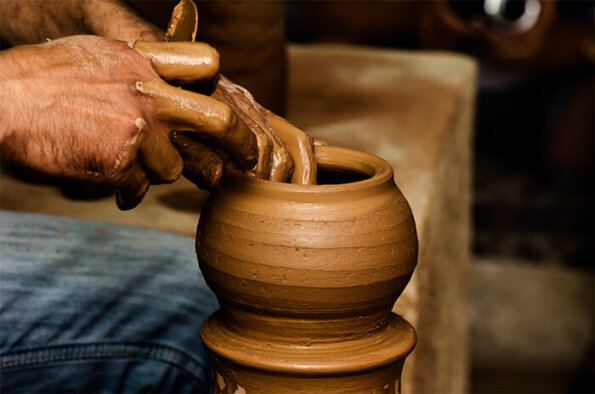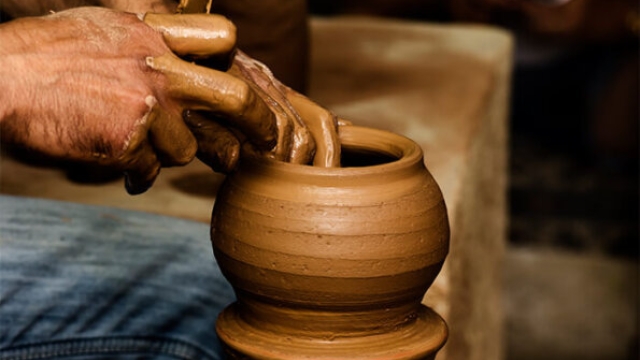
Pottery is more than just a craft; it is an intricate dance of earth, fire, and artistry, embodying both the tangible and the spiritual. Each piece tells a story, shaped by the hands of skilled artisans and transformed through the alchemical process of firing clay. In homes around the world, pottery serves as functional art, bridging the gap between utility and beauty, and connecting us to traditions that have spanned millennia.
At the heart of this creative journey is Amitābha Studio, where the ethos of uniqueness shines brightly. Specializing in crafting one-of-a-kind lamps from antique and vintage Delft and various other Dutch and Belgian pottery, the studio infuses each piece with a sense of history and character. These lamps not only illuminate spaces but also serve as conversation starters, inviting admiration for their craftsmanship and the rich stories they carry. Through the melding of old-world techniques and modern design, Amitābha Studio showcases the enduring allure of pottery, proving that art can indeed illuminate our lives in every sense.
The History of Delft Pottery
Delft pottery, known for its distinctive blue and white designs, originated in the city of Delft in the Netherlands during the 16th century. Its production was influenced by the arrival of Chinese porcelain in Europe, which captivated art lovers and patrons alike. As the demand for porcelain grew, local artisans sought to replicate its beauty, leading to the development of earthenware known as delftware. By incorporating cobalt blue pigment into their glazes, these craftsmen created a style that would become synonymous with Dutch culture.
During the 17th century, the Dutch Golden Age, Delft pottery flourished as trade prospered and artists explored new techniques. Factories such as De Porceleyne Fles and De Grieksche A have become emblematic of this era. Skilled potters and painters brought to life intricate patterns of windmills, flowers, and historical scenes that adorned everyday items and decorative objects. The craftsmanship and artistry involved in creating delftware not only heightened its appeal but also established it as a prestigious art form across Europe.
As time progressed, the allure of Delft pottery extended beyond functional wares to include decorative items, making it a sought-after collectible. In the contemporary era, artisans at studios like Amitābha continue to breathe new life into vintage and antique pieces, crafting unique lamps that retain the charm of traditional delftware. This evolution reflects the enduring legacy of Delft pottery, bridging the past with modern creativity in the art of ceramics.
The Art of Lamp Creation
Creating lamps from antique and vintage pottery is an intricate art form that blends functionality with aesthetic appeal. Amitābha Studio prides itself on transforming cherished pieces of Delft and other Dutch and Belgian pottery into beautiful, one-of-a-kind lighting fixtures. Each lamp tells its own story, capturing the essence of its historical background while serving modern-day purposes. The craftsmanship involved in this process honors the original artistry of the pottery while adding a new dimension through illumination.
The selection of materials is crucial in lamp creation. Amitābha Studio carefully curates its collection of antique pottery, ensuring that each piece not only has a unique design but also a rich history. The vibrant glazes and intricate patterns found in vintage Delftware inspire creativity and innovation, pushing the boundaries of typical lamp design. By respecting the original piece’s heritage, artisans can create lamps that preserve the past while adapting seamlessly to contemporary interiors.
In the final stages of transformation, the technical aspect of lamp-making comes into play. This involves integrating electrical components safely and stylishly without detracting from the pottery’s charm. The result is a stunning fusion of art and engineering, producing lamps that serve as captivating conversation starters in any space. Each creation embodies the spirit of the pottery, allowing the art of lamp-making to shine brightly in homes and galleries alike.
Sourcing Antique Pottery
Finding the right antique pottery involves a deep appreciation for history and craftsmanship. At Amitābha Studio, the journey begins with extensive research into various sources of antique and vintage ceramics. This includes exploring estate sales, auctions, and specialized antique shops where unique pieces often hide. Every lamp crafted carries the story of its origins, making it essential to seek out pottery that not only showcases beautiful designs but also reflects the cultural significance of the time it was made.
The selection process also requires a discerning eye to identify authentic Delft and other Dutch and Belgian pottery. Each piece tells a tale through its intricate patterns and glazing techniques, often requiring expertise to separate genuine antiques from reproductions. Collaborating with seasoned collectors and pottery experts ensures that only the finest pieces are chosen for transformation into lamps, capturing the essence of rich craftsmanship and heritage.
In addition to traditional sourcing methods, modern technology plays a role in accessing antique pottery. Online marketplaces and dedicated antique platforms provide an expansive reach, allowing Amitābha Studio to connect with sellers around the globe. By combining both traditional and contemporary sourcing techniques, the studio strives to curate a collection of lamps that not only illuminates spaces but also sparks conversations about art, history, and culture.
Sustainability in Pottery
Sustainability in pottery is an essential aspect that reflects the growing awareness of environmental issues within the craft. Artisans are increasingly focusing on eco-friendly practices, sourcing materials that have minimal impact on the planet. This includes using natural clays and glazes, which are not only safer for the environment but also enhance the authenticity of the pottery. By prioritizing sustainability, potters contribute to the preservation of natural resources while creating beautiful works of art.
The shift towards sustainability also extends to the methods of production. Many potters are embracing traditional techniques that require less energy and reduce waste. For example, wood-fired kilns are becoming more popular among artisans, as they produce less carbon emissions compared to gas or electric kilns. This connection to nature not only influences the aesthetic of the pottery but also reinforces the community’s commitment to environmentally responsible practices.
Amitābha Studio exemplifies this dedication to sustainability through its unique offerings. By repurposing antique and vintage Delft and other Dutch and Belgian pottery, the studio not only breathes new life into discarded items but also creates one-of-a-kind lamps with a rich history. This approach highlights the beauty of collaboration between artistry and sustainability, ensuring that each piece not only illuminates a space but also tells a story of mindful creation.
Chinoiserie Lamp
The Impact of Pottery on Home Décor
Pottery plays a significant role in enhancing the aesthetic appeal of home décor. Its unique textures and finishes add an organic touch to spaces, creating a warm and inviting atmosphere. From rustic earthenware to sleek contemporary ceramics, pottery can complement various design styles, making it a versatile choice for any interior. The personal and handcrafted nature of pottery imbues a space with character, transforming mundane areas into lively focal points.
The use of pottery in home décor extends beyond simple decorative pieces. Functional items such as vases, bowls, and lamps can offer both utility and beauty. For example, Amitābha Studio specializes in creating unique, one-of-a-kind lamps crafted from antique and vintage Delft and other Dutch and Belgian pottery. These lamps not only illuminate a room but also serve as conversation starters, revealing the history and craftsmanship behind each piece. Integrating such distinctive items into a home allows for a blend of practicality and artistry.
Moreover, pottery can reflect personal style and cultural heritage, providing a sense of identity within home spaces. Each piece carries its own story, whether it’s a family heirloom or a contemporary creation. By showcasing pottery, individuals can express themselves, curate their environment intentionally, and connect with traditions that resonate with their aesthetic. Thus, pottery significantly influences home décor, making it a cherished addition to many households.


